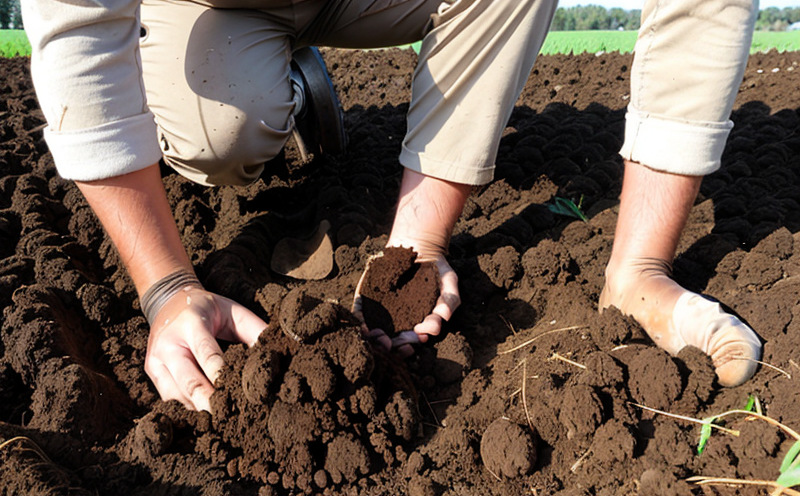Soil Chlorophyll Extract Testing (Plant-Soil Link)
The soil chlorophyll extract testing is a critical analytical procedure in agriculture and forestry that establishes the health status of soil and its potential to support plant growth. This test directly addresses the relationship between soil quality, nutrient availability, and overall crop productivity by evaluating the presence and concentration of chlorophyll within extracted soil samples.
Chlorophyll, essential for photosynthesis, is a key indicator of plant health and vigor. By assessing chlorophyll levels in soil extracts, agronomists and environmental scientists can infer the vitality of soil microbes and the potential for sustainable agricultural practices. This testing method provides insights into soil fertility, microbial activity, and the overall health of the ecosystem within which plants are rooted.
The methodology involves extracting soil samples with an aqueous solution that solubilizes chlorophyll pigments from soil particles. The extracted solution is then analyzed spectrophotometrically to measure the absorbance at specific wavelengths corresponding to chlorophyll a and b. This approach not only quantifies the chlorophyll content but also provides a non-destructive means of assessing soil quality.
The results of this testing are crucial for optimizing crop nutrition, managing soil health, and implementing sustainable agricultural practices. By identifying deficiencies in soil nutrients that affect plant chlorophyll synthesis, farmers can make informed decisions about fertilization strategies. Additionally, this test supports precision agriculture by providing data-driven insights into the spatial variability of soil quality across fields.
Incorporating soil chlorophyll extract testing into routine monitoring helps in early detection of soil degradation and nutrient deficiencies, thus enhancing crop yields and sustainability. It also plays a pivotal role in environmental protection efforts by ensuring that agricultural practices do not compromise soil health or local ecosystems.
| Sample Preparation | Air-dry and homogenize soil samples. Pass through a sieve (2 mm). |
|---|---|
| Extraction Solution | Petroleum ether or chloroform. |
| Analysis Method | Spectrophotometry at 645 nm and 663 nm wavelengths. |
| Standard Reference | ISO 18092: Soil quality — Determination of chlorophyll content in soil extracts using spectrophotometry. |
The testing process is designed to be robust and reproducible, ensuring accurate and reliable results that are essential for informed decision-making. By integrating this test into agricultural practices, stakeholders can achieve a balance between productivity and sustainability, fostering healthier soils and more resilient crops.
Benefits
The implementation of soil chlorophyll extract testing offers numerous advantages to various sectors involved in agriculture and forestry. This method provides actionable insights into the soil's health status, enabling stakeholders to optimize resource use efficiently while promoting sustainability.
For quality managers and compliance officers, this test ensures that agricultural practices comply with environmental regulations and industry standards. By identifying potential deficiencies early on, it helps prevent costly penalties and reputational damage associated with non-compliance.
R&D engineers benefit from the detailed data provided by soil chlorophyll extract testing as they develop new products and processes aimed at enhancing crop productivity. The insights gained into soil health can lead to innovations in fertilizers, pesticides, and other agricultural inputs that are both effective and sustainable.
Procurement teams can leverage this information to source high-quality raw materials for their operations, ensuring that the soil used meets stringent quality benchmarks. This not only improves product performance but also supports long-term sustainability goals.
In summary, soil chlorophyll extract testing is a cornerstone of modern agricultural and forestry practices, providing essential data that informs decisions at all levels from field management to corporate strategy.
Industry Applications
| Application | Description |
|---|---|
| Crop Nutrition Management | Detect deficiencies in essential nutrients affecting plant chlorophyll synthesis. |
| Sustainable Agriculture Practices | Implement precision agriculture techniques to enhance efficiency and reduce environmental impact. |
| Soil Health Monitoring | Identify early signs of soil degradation or nutrient imbalances that require intervention. |
| Environmental Protection | Ensure agricultural practices do not compromise local ecosystems or violate environmental laws. |
| Research and Development | Support innovation in agricultural products and processes by providing data-driven insights into soil health. |
| Agronomy Consulting | Offer tailored advice to farmers on optimizing their farming practices for better yields. |
| Education and Training | Use as a practical tool in agricultural education programs, fostering knowledge and skills among future industry professionals. |
The application of soil chlorophyll extract testing extends beyond individual farms to encompass regional and national initiatives aimed at improving overall soil quality. By providing comprehensive data on soil health, this test supports broader efforts to promote sustainable agriculture practices globally.
Environmental and Sustainability Contributions
The use of soil chlorophyll extract testing contributes significantly to environmental stewardship by promoting more sustainable agricultural practices. This method plays a vital role in minimizing the ecological footprint of farming activities while enhancing productivity and resilience.
One key benefit is reduced chemical input, as the test helps farmers identify precisely where and what nutrients are needed. This precision approach leads to lower levels of fertilizers and pesticides being used, thereby reducing pollution of water bodies and soil degradation. By focusing on targeted interventions rather than blanket applications, this testing method supports a more efficient use of resources.
Moreover, the test contributes to carbon sequestration efforts by promoting healthy soils that are better equipped to store carbon. Healthy soils have higher microbial activity and greater capacity for organic matter decomposition, which in turn enhances soil structure and fertility. This positive impact on soil health translates into enhanced resilience against climate change impacts such as droughts and floods.
The insights gained from soil chlorophyll extract testing also enable better land management practices, including reforestation projects and conservation agriculture techniques. By understanding the specific needs of different types of soils, stakeholders can implement strategies that maximize biodiversity and support ecosystem services.
In conclusion, soil chlorophyll extract testing is a powerful tool for fostering sustainability in agriculture and forestry by providing actionable data that supports environmentally responsible practices.





